The Blue Flag Programme is an international system for awarding beaches and marinas that meet some strict criteria. More than 3500 beaches throughout the world have been awarded with the Blue Flag, with Greek beaches being one of the most awarded. In Greece, the Blue Flag Programme is supported by the Greek Society for the Protection of Nature, which determines which beaches meet the relevant criteria.
The award of a blue flag beach is based on compliance with 32 strict criteria covering the aspects of environmental education and information, water quality, environmental management, safety and services
Because the program is an indicator of proper management of the beaches and their quality, Cretans have made great efforts for classifying as many beaches in the Blue Flag program, as possible. Most beaches are located on the northern coast of the island, which are the most touristy, but there are some on the south coasts.
The award of a blue flag beach is based on the following criteria.
Environmental Education and Information
- Information about the Blue Flag must be displayed
- Environmental education activities must be offered and promoted to beach users
- Information about bathing water quality must be displayed
- Information relating to local eco-systems and environmental phenomena must be displayed
- A map of the beach indicating different facilities must be displayed
- A code of conduct that reflects appropriate laws governing the use of the beach and surrounding areas must be displayed
Water quality
The beach must fully comply with the water quality sampling and frequency requirements
The beach must fully comply with the standards and requirements for water quality analysis
No industrial, waste-water or sewage-related discharges should affect the beach area
The beach must comply with the Blue Flag requirements for the microbiological parameter faecal coli bacteria (E.coli) and intestinal enterococci/streptococci
The beach must comply with the Blue Flag requirements for the following physical and chemical parameters\
Environmental Management
- The local authority/beach operator should establish a beach management committee
- The local authority/beach operator must comply with all regulations affecting the location and operation of the beach
- The beach must be clean
- Algae vegetation or natural debris should be left on the beach
- Waste disposal bins/containers must be available at the beach in adequate numbers and they must be regularly maintained
- Facilities for the separation of recyclable waste materials should be available at the beach
- An adequate number of toilet or restroom facilities must be provided
- The toilet or restroom facilities must be kept clean
- The toilet or restroom facilities must have controlled sewage disposal
- On the beach there will be no unauthorised camping or driving and no dumping
- Access to the beach by dogs and other domestic animals must be strictly controlled
- All buildings and beach equipment must be properly maintained
- Coral reefs in the vicinity of the beach must be monitored
- A sustainable means of transportation should be promoted in the beach area
Safety and services
- An adequate number of lifeguards and/or lifesaving equipment must be available at the beach
- First aid equipment must be available on the beach
- Emergency plans to cope with pollution risks must be in place
- There must be management of different users and uses of the beach so as to prevent conflicts and accidents
- There must be safety measures in place to protect users of the beach
- A supply of drinking water should be available at the beach
- At least one Blue Flag beach in each municipality must have access and facilities provided for the physically disabled
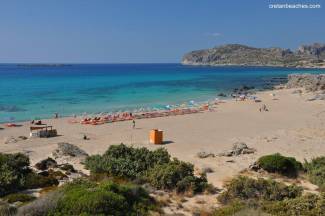
The exotic beach of Falassarna is located 59km west of Chania and 17km west of Kissamos. It’s located in the western part of Cape Gramvousa. At the northern end of the beach are the ruins of the ancient Roman city of Falassarna.
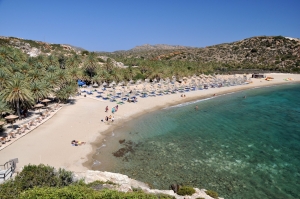
Vai was totally unknown until the early 1970s, when a popular commercial for the Bounty chocolate with coconut was filmed here, using the magical background of palm trees. In the advert, coconuts were falling from trees, however Vai palms produce dates. Consequently coconuts had to be falsely hung to create the right impression. The ad made this unknown earthly paradise renowned throughout the world.
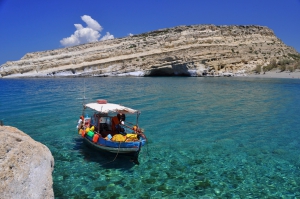
Matala is famous for the carved caves in the rocks and the hippies of the ‘70s. It is located close to Phaestus, the second-largest palace of the Minoan civilization. Matala was the port of Phaestus, and in the Roman Times, it became a port of Gortys.

Georgioupolis is a seaside resort located 38km east of Chania and 21km west of Rethymnon. It is a small coastal town, situated in a lush valley filled with rivers and springs. The town lies on the western edge of a vast long beach with 10km length. Georgioupolis Beach stretches 2km to the east, starting from the river Almiros and ending in Kavros Beach, which is a natural extension of the first beach.

In front of the touristic settlement, there is a nice sandy beach with turquoise waters. The sea surface is mainly flat because the beach has an easterly orientation. while winds in Crete come mainly from the west. The beach is organized with umbrellas, sunbeds, and water sports.
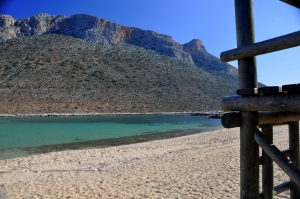
Stavros (i.e. cross) is a seaside village located 17km northeast of Chania, at the northernmost edge of Cape Akrotiri. One characteristic feature of the area is the very steep camel-shaped mountain rising opposite the harbor of Stavros. The mountain is famous because there were filmed scenes for the film “Zorba the Greek”, where Anthony Quinn danced the famous Sirtaki Dance in 1964. Then Stavros was a small fishing village.
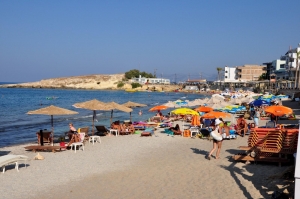
The first beach you come across east of the port of Hersonissos is a long sandy narrow beach, which is flooded by thousands of people. It is very well organized and close to the amenities of the city. However, it is inappropriate for those who do not like crowds.
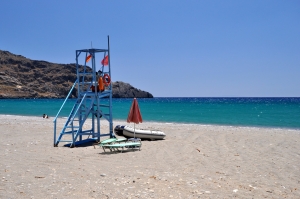
Plakias is a popular tourist resort, located 36km south of Rethymno city, at the exit of a fertile valley surrounded by high mountains and dense olive groves. Next to it empties the river Kotsifos.












































































